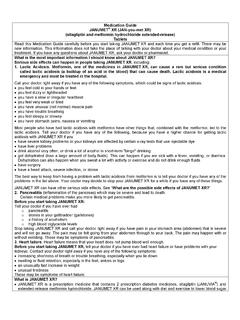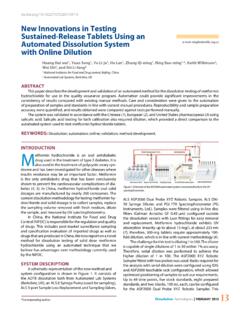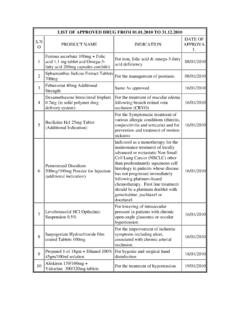Transcription of Metformin Hydrochloride Extended-Release …
1 Page 1 of 22 Metformin Hydrochloride Extended-Release Tablets 500 mg and 1000 mg Rx only DESCRIPTION Metformin Hydrochloride Extended-Release tablets contain an oral antihyperglycemic drug used in the management of type 2 diabetes. Metformin Hydrochloride (N, N-dimethylimidodicarbonimidic diamide Hydrochloride ) is a member of the biguanide class of oral antihyperglycemics and is not chemically or pharmacologically related to any other class of oral antihyperglycemic agents. The empirical formula of Metformin Hydrochloride is C4H11N5 HCl and its molecular weight is Its structural formula is: Metformin Hydrochloride is a white to off-white crystalline powder that is freely soluble in water and is practically insoluble in acetone, ether, and chloroform.
2 The pKa of Metformin is The pH of a 1% aqueous solution of Metformin Hydrochloride is Metformin Hydrochloride Extended-Release tablets are designed for once-a-day oral administration and deliver 500 mg or 1000 mg of Metformin Hydrochloride . In addition to the active ingredient Metformin Hydrochloride , each tablet contains the following inactive ingredients: ammonio methacrylate copolymer type A, ammonio methacrylate copolymer type B, colloidal silicone dioxide, crospovidone, dibutyl sebacate, hypromellose, magnesium stearate, microcrystalline cellulose and povidone. USP dissolution test for Metformin Hydrochloride Extended-Release tablet is pending.
3 SYSTEM COMPONENTS AND PERFORMANCE Metformin Hydrochloride Extended-Release tablet is designed for once-a-day oral administration using the swellable matrix coated with a permeable membrane technology. The tablet is similar in appearance to other film-coated oral administered tablets but it consists of a swellable active core formulation that is coated by a permeable membrane. The core formulation is composed primarily of drug with swellable matrix excipients. Upon ingestion, water is taken up through the membrane, which in turn causes swelling of the polymer in an active core which control the drug release from the membrane.
4 The rate of drug delivery is totally depending on the degree of swelling of the control release polymer and membrane thickness. CLINICAL PHARMACOLOGY Mechanism of Action Metformin is an antihyperglycemic agent which improves glucose tolerance in patients with type 2 diabetes, lowering both basal and postprandial plasma glucose. Its pharmacologic mechanisms of action are different from other classes of oral antihyperglycemic agents. Metformin decreases hepatic glucose production, decreases intestinal absorption of glucose, and improves insulin sensitivity by increasing peripheral glucose uptake and utilization.
5 Unlike sulfonylureas, Metformin does not produce hypoglycemia in either patients with type 2 diabetes or normal Page 2 of 22 subjects (except in special circumstances, see PRECAUTIONS) and does not cause hyperinsulinemia. With Metformin therapy, insulin secretion remains unchanged while fasting plasma insulin levels and day-long plasma insulin response may actually decrease. PHARMACOKINETICS AND DRUG METABOLISM Absorption and Bioavailability The appearance of Metformin in plasma from a Metformin Hydrochloride Extended-Release tablet is slower and more prolonged compared to immediate- release Metformin .
6 In a multiple-dose crossover study, 23 patients with type 2 diabetes mellitus were administered either Metformin Hydrochloride Extended-Release tablets 2000 mg once a day (after dinner) or immediate- release (IR) Metformin Hydrochloride 1000 mg twice a day (after breakfast and after dinner). After 4 weeks of treatment, steady-state pharmacokinetic parameters, area under the concentration-time curve (AUC), time to peak plasma concentration (Tmax), and maximum concentration (Cmax) were evaluated. Results are presented in Table 1. Table 1 extended - release Metformin vs. Immediate- release Metformin Steady-State Pharmacokinetic Parameters at 4 Weeks Pharmacokinetic Parameters (mean SD) extended - release Metformin 2000 mg (administered q.)
7 D. after dinner) Immediate- release Metformin 2000 mg (1000 mg ) AUC 0-24 hr (ng hr/mL) 26,811 7055 27,371 5,781 Tmax (hr) 6 (3-10) 3 (1-8) Cmax (ng/mL) 2849 797 1820 370 In four single-dose studies and one multiple-dose study, the bioavailability of Metformin Hydrochloride Extended-Release tablet 2000 mg given once daily, in the evening, under fed conditions [as measured by the area under the plasma concentration versus time curve (AUC)] was similar to the same total daily dose administered as immediate release Metformin 1000 mg given twice daily. The geometric mean ratios ( Metformin Extended-Release / immediate- release Metformin ) of AUC0-24hr, AUC0-72hr, and AUC0-inf.
8 For these five studies ranged from to In a single-dose, four-period replicate crossover design study, comparing two 500 mg Metformin Hydrochloride Extended-Release tablets to one 1000 mg Metformin Hydrochloride Extended-Release tablet administered in the evening with food to 29 healthy male subjects, two 500 mg Metformin Hydrochloride Extended-Release tablets were found to be equivalent to one 1000 mg Metformin Hydrochloride Extended-Release tablet. In a study carried out with Metformin Hydrochloride Extended-Release tablets, there was a dose-associated increase in Metformin exposure over 24 hours following oral administration of 1000, 1500, 2000, and 2500 mg.
9 In three studies with Metformin Hydrochloride Extended-Release tablets using different treatment regimens (2000 mg after dinner; 1000 mg after breakfast and after dinner; and 2500 mg after dinner), the pharmacokinetics of Metformin as measured by AUC appeared linear following multiple-dose administration. The extent of Metformin absorption (as measured by AUC) from Metformin Hydrochloride Extended-Release tablets was increased by approximately 60% when given with food. When Metformin Hydrochloride Extended-Release tablet was administered with food, Cmax was increased by approximately 30% and Tmax was more prolonged compared with the fasting state ( versus hours).
10 Page 3 of 22 Distribution Distribution studies with Metformin Hydrochloride Extended-Release tablets have not been conducted. However, the apparent volume of distribution (V/F) of Metformin following single oral doses of immediate- release Metformin 850 mg averaged 654 358 L. Metformin is negligibly bound to plasma proteins, in contrast to sulfonylureas, which are more than 90% protein bound. Metformin partitions into erythrocytes, most likely as a function of time. At usual clinical doses and dosing schedules of immediate- release Metformin , steady state plasma concentrations of Metformin are reached within 24-48 hours and are generally <1 mcg/mL.








